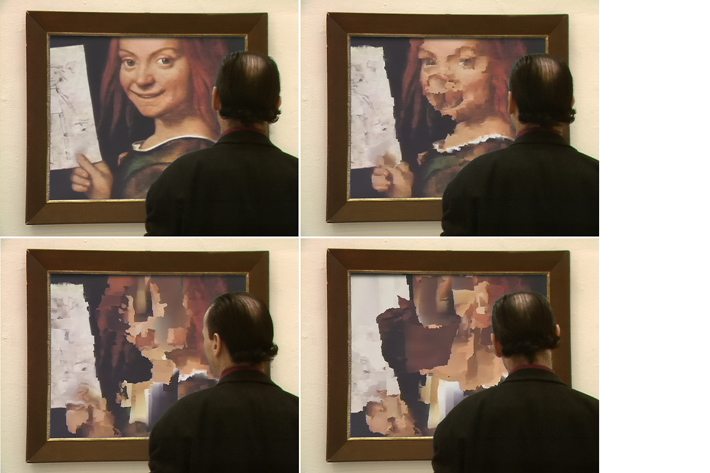| video
|
Visitors of an exhibition find themselves in front of a painting. Upon coming closer they notices that exactly the spot of the picture they are looking at is changing under their gaze. The interaction with the picture seems to destroy or deconstruct it, preventing them from looking at it in the traditional way. The process of perception changes the object of perception in realtime. This puts museum visitors into a situation in which their acquired mode of perceiving art no longer applies, and they are forcibly confronted with a fundamentally different concept of art.
In the early 1990s, the computer was still seen as tool rather than a medium. Artists who used computers generally did so with the aim of producing visual art which in aesthetic terms was still relatively similar to painting and drawing. Instead of using the true potential of the digital technologies to create new concepts and a new kind of aesthetics, they had merely swapped their paintbrush for a mouse. The zerseher was developed in response to this and aimed to introduce the computer as an artistic medium in its own right and propagate one of its most notable properties: interactivity.
The painting used in the installation is giovanni Francesco Caroto’s "portrait of a young boy holding a child’s drawing", the first painting in art history to take a child’s drawing as its subject. This artwork had been chosen to illustrate the still very novel and inchoate state of new media in the early 1990s.
Technical setup: A framed rear-projection on a canvas displays the painting. Behind this screen an eye-tracker is installed: A camera is pointing at the viewers eyes. A software analyses the video-signal and locates the center of the iris and a reflections of an infrared-lightsource in the viewers eyes. with this it can calculate exactly on which part of the painting the viewer is looking at. These coordinates are then used to distort the picture at exactly these spots. This means that as soon as a viewer looks at a particular part of the picture this part is distorted. Whereas formerly old masters left an impression on visitors, visitors were now leaving their impressions on the old master.
If no one looks at the picture for more than 30 seconds the picture goes back to its original condition.
Co-author: Dirk Luesebrink



